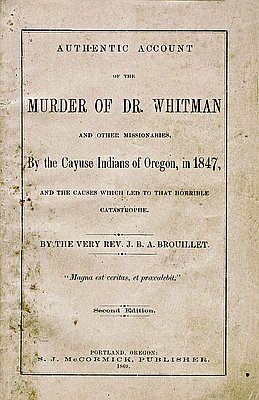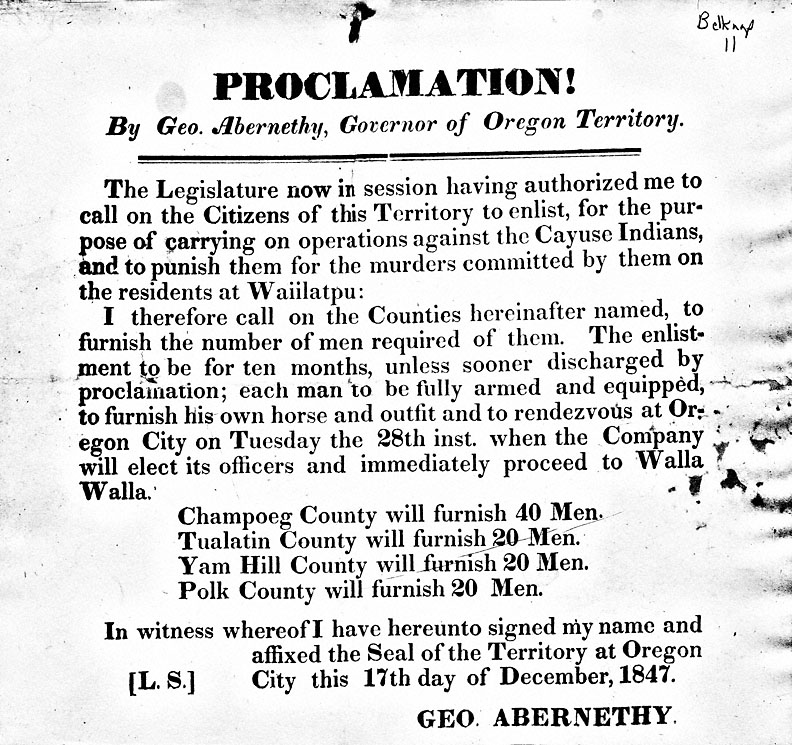- Catalog No. —
- Belknap 11
- Date —
- December 17, 1847
- Era —
- 1846-1880 (Treaties, Civil War, and Immigration)
- Themes —
- Government, Law, and Politics, Native Americans, Oregon Trail and Resettlement, Religion
- Credits —
- Oregon Historical Society
- Regions —
- Oregon Country
- Author —
- George Abernethy
Proclamation from Governor George Abernethy
Oregon Provisional Governor George Abernethy issued this proclamation for the raising of a voluntary militia following an authorization from the Oregon Provisional Legislature. The legislature’s intent was to respond to the Native attack on the Presbyterian mission at Waiilatpu late November 1847, commonly referred to as the Whitman Massacre.
Presbyterian missionaries Marcus and Narcissa Whitman arrived in the Oregon Country in the fall of 1836 and established a mission at Waiilaptu, near present-day Walla Walla, Washington. The Whitman Mission was located in the traditional territory of the Cayuse, a Plateau group which had adopted aspects of the Plains equestrian culture. The Whitmans were motivated by an intense desire to Christianize the Cayuse and convince them to adopt a settled, agrarian lifestyle. The Cayuse expected the newcomers to compensate them for use of their land and resources, which Marcus Whitman refused to do. Owing to differing expectations and cultural traditions, relations between the Whitmans and the Cayuse were less than harmonious. By the mid-1840s relations between the two had seriously deteriorated due to the Whitman’s support for American emigration to Oregon, the effects of infectious diseases epidemics, and the killing of a young Cayuse man, Elijah Hedding, by settlers while on a trip to California.
Believing that Marcus Whitman was determined to see the Plateau peoples perish or removed from their lands, a Cayuse band attacked the mission in what they perceived as a defensive action. The attackers killed thirteen missionaries and settlers, including the Whitmans, and took some fifty hostages. Following negotiations first with the local Catholic bishop, Augustin Blanchet, and then Hudson’s Bay Company Chief Trader, Peter Skene Ogden, the hostages were evacuated to Fort Vancouver and a message from four Cayuse leaders was sent to Governor Abernethy. Several Cayuse leaders had declined to support the attack and sought a peace conference with Abernethy to avert further bloodshed. However, as Abernethy’s proclamation demonstrates, the settler population based in the Willamette Valley chose to raise a volunteer militia against the perceived Cayuse threat. The volunteer militia subsequently engaged in a series of skirmishes with several Cayuse bands but was unsuccessful in securing a clear military victory. The Cayuse War finally ended after regular U.S. Army troops arrived in Oregon and five Cayuse men surrendered to government offiicials in April 1850. After a short trial, the five Cayuse were convicted of the Whitman mission deaths and hanged on June 3, 1850.
Further Reading:
Stern, Theodore. “Cayuse, Umatilla, and Walla Walla.” In The Handbook of North American Indians. Vol. 12 Plateau. Washington D.C., 1998: 395-419.
Stern, Theodore. Chiefs and Change in the Oregon Country. Vol. 2. Indians Relations at Fort Nez Perces, 1818-1853. Corvallis, Oreg., 1996.
Jeffery, Julie Joy. Converting the West: A Biography of Narcissa Whitman. Norman, Okla., 1991.
Written by Melinda Jette, © Oregon Historical Society, 2003.
Related Historical Records
-
Outposts, Farms, and Missions
The commerce-oriented exploration of the North Pacific Coast by European and American sea captains became active during the 1790s. The 1792 incursions into the mouth of the Columbia …
-
Brouillet's Account of the Murder of Dr. Whitman
In 1869 Jean Baptiste Brouillet, a French Canadian Catholic missionary to Oregon, published the Authentic Account of the Murder of Dr. Whitman and Other Missionaries by the Cayuse Indians …

